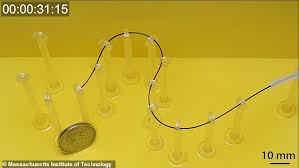
Breaking News
 Crypto Will Cause The Next Trillon Dollar Crash
Crypto Will Cause The Next Trillon Dollar Crash
 They've Just Crossed The Line...
They've Just Crossed The Line...
 Here's What It's Really Like to Live as a Christian in the Holy Land
Here's What It's Really Like to Live as a Christian in the Holy Land
 Vance Announces Major Breakthrough In Ukraine, Says Kiev Must Relinquish Land & US Won't...
Vance Announces Major Breakthrough In Ukraine, Says Kiev Must Relinquish Land & US Won't...
Top Tech News
 3D printing set to slash nuclear plant build times & costs
3D printing set to slash nuclear plant build times & costs
 You can design the wheels for NASA's next moon vehicle with the 'Rock and Roll Challenge
You can design the wheels for NASA's next moon vehicle with the 'Rock and Roll Challenge
 'Robot skin' beats human reflexes, transforms grip with fabric-powered touch
'Robot skin' beats human reflexes, transforms grip with fabric-powered touch
 World's first nuclear fusion plant being built in US to power Microsoft data centers
World's first nuclear fusion plant being built in US to power Microsoft data centers
 The mitochondria are more than just the "powerhouse of the cell" – they initiate immune...
The mitochondria are more than just the "powerhouse of the cell" – they initiate immune...
 Historic Aviation Engine Advance to Unlock Hypersonic Mach 10 Planes
Historic Aviation Engine Advance to Unlock Hypersonic Mach 10 Planes
 OpenAI CEO Sam Altman Pitches Eyeball-Scanning World ID to Bankers
OpenAI CEO Sam Altman Pitches Eyeball-Scanning World ID to Bankers
 New 3D-printed titanium alloy is stronger and cheaper than ever before
New 3D-printed titanium alloy is stronger and cheaper than ever before
 What is Unitree's new $6,000 humanoid robot good for?
What is Unitree's new $6,000 humanoid robot good for?
 "No CGI, No AI, Pure Engineering": Watch Raw Footage Of 'Star Wars'-Style Speeder
"No CGI, No AI, Pure Engineering": Watch Raw Footage Of 'Star Wars'-Style Speeder
'Worm-like' robot that crawls through the brain could treat stroke patients by clearing...

A tiny worm-like robot has been developed to treat stroke patients by clearing blood vessel blockages and delivering drugs directly to the brain.
The 0.5mm-wide wire is driven through the body using magnetic fields which can be computer controlled from outside the room.
Although it hasn't yet been tested on a human patient, engineers have proved its functions on a miniature obstacle course and in a life-size model of the brain.
They hope it will one day be used to treat people with life-threatening bleeding or blockages in the brain and speed up therapy to save vital moments.
Scientists at the Massachusetts Institute of Technology in Boston developed the miniscule snake-like robot, which is a few centimetres long.
It's made of a flexible mix of nickel and titanium and coated with a lubricating hydrogel which helps it to slip through tight tubes without damaging tissue.



